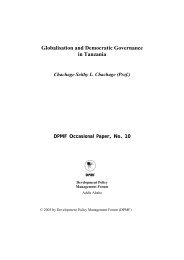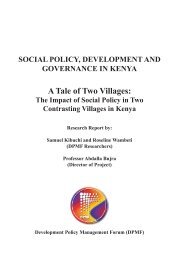From the Lagos Plan of Action (LPA) - DPMF.org
From the Lagos Plan of Action (LPA) - DPMF.org
From the Lagos Plan of Action (LPA) - DPMF.org
Create successful ePaper yourself
Turn your PDF publications into a flip-book with our unique Google optimized e-Paper software.
2 <strong>DPMF</strong> Occasional Paper No. 13NEPAD (New Partnership for African Development) which articulates <strong>the</strong>latest African Vision has, in essence, internalised <strong>the</strong> external vision andarticulates it as a consensus African vision hailed by <strong>the</strong> externals - asrepresented by <strong>the</strong> G8 countries. The development vision <strong>of</strong> NEPAD is,essentially, <strong>the</strong> same vision <strong>of</strong> <strong>the</strong> type <strong>of</strong> development propounded by <strong>the</strong>externals in different languages, since <strong>the</strong> time <strong>of</strong> independence. NEPADnow articulates an approach to development which is accepted by mostAfrican leaders, as well as leaders <strong>of</strong> <strong>the</strong> G8 countries.2. A History <strong>of</strong> African Visions2.1 The Pan-African Congress and its African VisionSince <strong>the</strong> last century African leaders – both in <strong>the</strong> Diaspora and in <strong>the</strong>Continent - began to view <strong>the</strong> continent as a whole instead <strong>of</strong> asfragmented pieces. They also began to discuss continental development, asopposed to piecemeal development, in specific countries or regions <strong>of</strong> <strong>the</strong>continent. These views <strong>of</strong> <strong>the</strong> continent were slowly incorporated into <strong>the</strong>nationalist struggle and received <strong>the</strong>ir clearest articulation during <strong>the</strong>struggle for independence.The Pan-African Congress held in Manchester, in 1945, brought toge<strong>the</strong>rAfrican nationalist leaders, as well as leaders from <strong>the</strong> Diaspora andexpressed Africa’s vision in <strong>the</strong> following terms: (a) to achieveindependence from colonial rule throughout <strong>the</strong> continent, so that Africanscan rule <strong>the</strong>mselves democratically, (b) to achieve continental unity so thatAfrica can (i) experience faster economic growth and catch up with <strong>the</strong>industrialised countries, and (ii) assume a strong position within <strong>the</strong>international system.This Pan-African vision was popularised at <strong>the</strong> sub-regional level asnationalist movements mobilised peasants and workers for <strong>the</strong> struggleagainst colonial rule. And <strong>the</strong> nationalist movements achieved <strong>the</strong>irindependence with this vision in mind.2.2 The First OAU VisionWhen <strong>the</strong> OAU was created in Addis Ababa, in 1963, <strong>the</strong> Pan-Africanvision was incorporated in its Charter. Indeed this vision became <strong>the</strong>subject <strong>of</strong> a heated debate at <strong>the</strong> 1963 meeting. The famous debate centredon a crucial element <strong>of</strong> <strong>the</strong> African vision namely, should <strong>the</strong> political




